离线安装完成后,一般情况下只装了个基础环境,catalog镜像没有导入,本文主要侧重在jenkins的一些环境设置和演示。
1.导入镜像
首先follow下面链接下载镜像
https://docs.openshift.com/container-platform/3.11/install/disconnected_install.html
我们这里下载的主要是
$ docker pull registry.redhat.io/openshift3/jenkins-2-rhel7:<tag>
$ docker pull registry.redhat.io/openshift3/jenkins-slave-maven-rhel7:<tag>
$ docker pull registry.redhat.io/openshift3/jenkins-slave-nodejs-rhel7:<tag>
导入到本地镜像仓库
[root@node2 images]# docker images REPOSITORY TAG IMAGE ID CREATED SIZE registry.example.com/openshift3/jenkins-2-rhel7 latest 0f36706e2c53 10 months ago 1.13 GB registry.example.com/openshift3/jenkins-slave-maven-rhel7 latest 5ce887d9bf31 11 months ago 1.02 GB registry.example.com/openshift3/jenkins-slave-nodejs-rhel7 latest a32c719893f2 11 months ago 971 MB
但现在进入查看jenkins image stream, 发现仍然是不可用状态。
[root@master ~]# oc describe is jenkins -n openshift Name: jenkins Namespace: openshift Created: 5 months ago Labels: <none> Annotations: openshift.io/display-name=Jenkins openshift.io/image.dockerRepositoryCheck=2019-08-30T14:32:54Z Docker Pull Spec: docker-registry.default.svc:5000/openshift/jenkins Image Lookup: local=false Unique Images: 1 Tags: 3 1 tagged from registry.example.com/openshift3/jenkins-1-rhel7:latest prefer registry pullthrough when referencing this tag Provides a Jenkins 1.X server on RHEL 7. For more information about using this container image, including OpenShift considerations, see https://github.com/openshift/jenkins/blob/master/README.md. Tags: hidden, jenkins ! error: Import failed (InternalError): Internal error occurred: Get https://registry.example.com/v2/: dial tcp 192.168.56.105:443: connect: connection refused 5 months ago
执行导入
oc import-image jenkins --from=registry.example.com/openshift3/jenkins-2-rhel7:latest --confirm --insecure=true
确认导入成功后,在项目中选择Jenkins(Ephemeral),然后等待创建完成。

注意这只是生成一个jenkins master环境。
同样导入用到的其他镜像
oc import-image mongodb:3.2 --from=registry.example.com/rhscl/mongodb-32-rhel7:latest --confirm --insecure=true oc import-image tomcat:8-slim --from=registry.example.com/tomcat:8-slim --confirm --insecure=true
2. 简单演示Pipeline部署
创建一个samplepiple.yaml文件,文件里面创建了一个pipeline,mongodb svc, mongodb 数据库。
因为是拿别人的修改的,所以里面的很多parameter没有用到。
apiVersion: v1 kind: Template labels: template: application-template-sample-pipeline message: |- A Jenkins server must be instantiated in this project to manage the Pipeline BuildConfig created by this template. You will be able to log in to it using your OpenShift user credentials. metadata: annotations: openshift.io/display-name: Pipeline Build Example description: |- This example showcases the new Jenkins Pipeline integration in OpenShift, which performs continuous integration and deployment right on the platform. The template contains a Jenkinsfile - a definition of a multi-stage CI/CD process - that leverages the underlying OpenShift platform for dynamic and scalable builds. OpenShift integrates the status of your pipeline builds into the web console allowing you to see your entire application lifecycle in a single view. iconClass: icon-jenkins tags: instant-app,jenkins name: jenkins-pipeline-example parameters: - description: The name assigned to all of the frontend objects defined in this template. displayName: Name name: NAME required: true value: nodejs-mongodb-example - description: The exposed hostname that will route to the Node.js service, if left blank a value will be defaulted. displayName: Application Hostname name: APPLICATION_DOMAIN - description: The URL of the repository with your application source code. displayName: Git Repository URL name: SOURCE_REPOSITORY_URL required: true value: https://github.com/openshift/nodejs-ex.git - displayName: Database Name name: DATABASE_NAME required: true value: sampledb - description: Username for MongoDB user that will be used for accessing the database. displayName: MongoDB Username from: user[A-Z0-9]{3} generate: expression name: DATABASE_USER - description: Password for the MongoDB user. displayName: MongoDB Password from: '[a-zA-Z0-9]{16}' generate: expression name: DATABASE_PASSWORD - description: Maximum amount of memory the Node.js container can use. displayName: Memory Limit name: MEMORY_LIMIT required: true value: 512Mi - description: Maximum amount of memory the MongoDB container can use. displayName: Memory Limit (MongoDB) name: MEMORY_MONGODB_LIMIT required: true value: 512Mi - displayName: Database Service Name name: DATABASE_SERVICE_NAME required: true value: mongodb - description: Password for the database admin user. displayName: Database Administrator Password from: '[a-zA-Z0-9]{16}' generate: expression name: DATABASE_ADMIN_PASSWORD - description: Set this to a branch name, tag or other ref of your repository if you are not using the default branch. displayName: Git Reference name: SOURCE_REPOSITORY_REF - description: Set this to the relative path to your project if it is not in the root of your repository. displayName: Context Directory name: CONTEXT_DIR - description: Github trigger secret. A difficult to guess string encoded as part of the webhook URL. Not encrypted. displayName: GitHub Webhook Secret from: '[a-zA-Z0-9]{40}' generate: expression name: GITHUB_WEBHOOK_SECRET - description: A secret string used to configure the Generic webhook. displayName: Generic Webhook Secret from: '[a-zA-Z0-9]{40}' generate: expression name: GENERIC_WEBHOOK_SECRET - description: The custom NPM mirror URL displayName: Custom NPM Mirror URL name: NPM_MIRROR - description: The OpenShift Namespace where the NodeJS and MongoDB ImageStreams reside. displayName: Namespace name: NAMESPACE required: true value: openshift objects: - apiVersion: v1 kind: BuildConfig metadata: annotations: pipeline.alpha.openshift.io/uses: '[{"name": "${NAME}", "namespace": "", "kind": "DeploymentConfig"}]' labels: name: sample-pipeline name: sample-pipeline spec: strategy: jenkinsPipelineStrategy: jenkinsfile: |- try { timeout(time: 20, unit: 'MINUTES') { node('nodejs') { stage('deploy') { openshift.withCluster() { openshift.withProject() { openshift.newApp("tomcat:8-slim", "--name=mytomcat").narrow('svc').expose() } } } } } } catch (err) { echo "in catch block" echo "Caught: ${err}" currentBuild.result = 'FAILURE' throw err } type: JenkinsPipeline triggers: - github: secret: secret101 type: GitHub - generic: secret: secret101 type: Generic - apiVersion: v1 kind: Service metadata: annotations: description: Exposes the database server name: ${DATABASE_SERVICE_NAME} spec: ports: - name: mongodb port: 27017 targetPort: 27017 selector: name: ${DATABASE_SERVICE_NAME} - apiVersion: v1 kind: DeploymentConfig metadata: annotations: description: Defines how to deploy the database name: ${DATABASE_SERVICE_NAME} spec: replicas: 1 selector: name: ${DATABASE_SERVICE_NAME} strategy: type: Recreate template: metadata: labels: name: ${DATABASE_SERVICE_NAME} name: ${DATABASE_SERVICE_NAME} spec: containers: - env: - name: MONGODB_USER value: ${DATABASE_USER} - name: MONGODB_PASSWORD value: ${DATABASE_PASSWORD} - name: MONGODB_DATABASE value: ${DATABASE_NAME} - name: MONGODB_ADMIN_PASSWORD value: ${DATABASE_ADMIN_PASSWORD} image: ' ' livenessProbe: initialDelaySeconds: 30 tcpSocket: port: 27017 timeoutSeconds: 1 name: mongodb ports: - containerPort: 27017 readinessProbe: exec: command: - /bin/sh - -i - -c - mongo 127.0.0.1:27017/$MONGODB_DATABASE -u $MONGODB_USER -p $MONGODB_PASSWORD --eval="quit()" initialDelaySeconds: 3 timeoutSeconds: 1 resources: limits: memory: ${MEMORY_MONGODB_LIMIT} volumeMounts: - mountPath: /var/lib/mongodb/data name: ${DATABASE_SERVICE_NAME}-data volumes: - emptyDir: medium: "" name: ${DATABASE_SERVICE_NAME}-data triggers: - imageChangeParams: automatic: true containerNames: - mongodb from: kind: ImageStreamTag name: mongodb:3.2 namespace: ${NAMESPACE} type: ImageChange - type: ConfigChange
oc new-project pipelineproject oc new-app -f samplepipeline.yaml --> Deploying template "pipelineproject/jenkins-pipeline-example" for "samplepipeline.yaml" to project pipelineproject Pipeline Build Example --------- This example showcases the new Jenkins Pipeline integration in OpenShift, which performs continuous integration and deployment right on the platform. The template contains a Jenkinsfile - a definition of a multi-stage CI/CD process - that leverages the underlying OpenShift platform for dynamic and scalable builds. OpenShift integrates the status of your pipeline builds into the web console allowing you to see your entire application lifecycle in a single view. A Jenkins server must be instantiated in this project to manage the Pipeline BuildConfig created by this template. You will be able to log in to it using your OpenShift user credentials. * With parameters: * Name=nodejs-mongodb-example * Application Hostname= * Git Repository URL=https://github.com/openshift/nodejs-ex.git * Database Name=sampledb * MongoDB Username=userYOB # generated * MongoDB Password=k3XGgVjtUljSY8Tm # generated * Memory Limit=512Mi * Memory Limit (MongoDB)=512Mi * Database Service Name=mongodb * Database Administrator Password=1R4HJpe3kYHYpYb3 # generated * Git Reference= * Context Directory= * GitHub Webhook Secret=H23NSFhL2aiYBUX7YQJHOfSktEgFEdf2Oofi5hr8 # generated * Generic Webhook Secret=PUsLojY1wddyQNTg3w2JfDi5LNa8LfOdpSGP8bPO # generated * Custom NPM Mirror URL= * Namespace=openshift --> Creating resources ... buildconfig.build.openshift.io "sample-pipeline" created service "mongodb" created deploymentconfig.apps.openshift.io "mongodb" created --> Success Use 'oc start-build sample-pipeline' to start a build. Application is not exposed. You can expose services to the outside world by executing one or more of the commands below: 'oc expose svc/mongodb' Run 'oc status' to view your app.
查看一下console,同时等待ready.
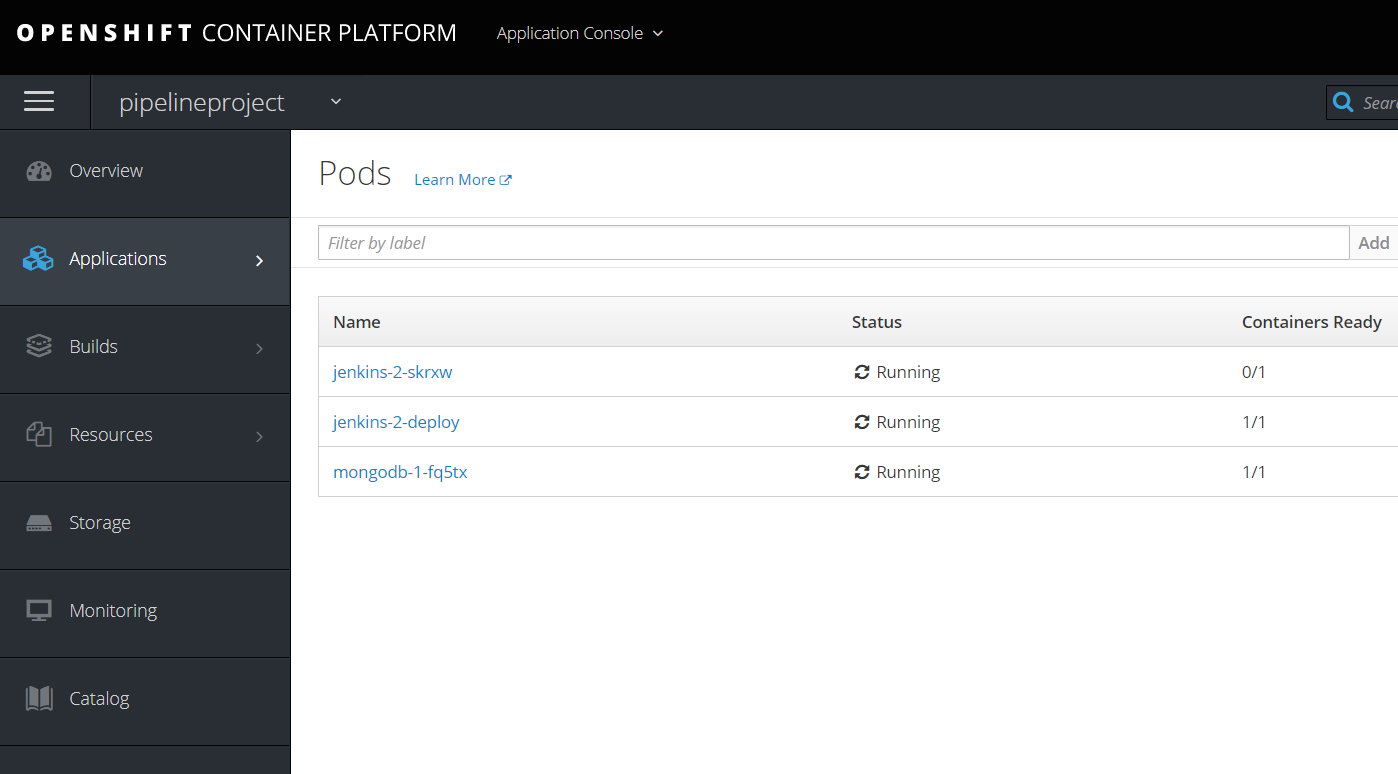
在jenkins的deployment下环境变量中加入 NODEJS_SLAVE_IMAGE=registry.example.com/openshift3/jenkins-slave-nodejs-rhel7,保存生效
如果不加入环境变量,slave的镜像就会从redhat官网上拉取了。
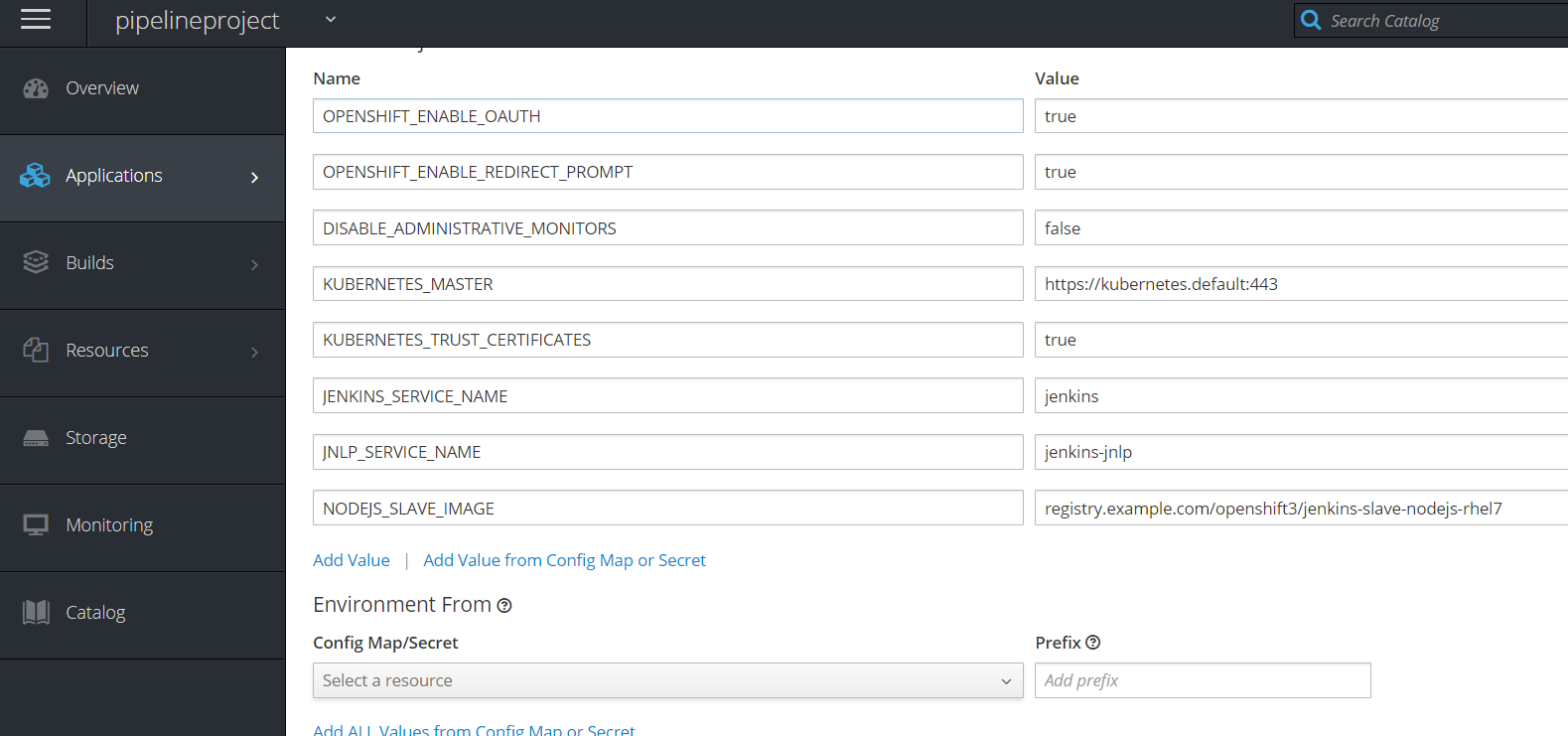
进入pipeline页面,看configuration
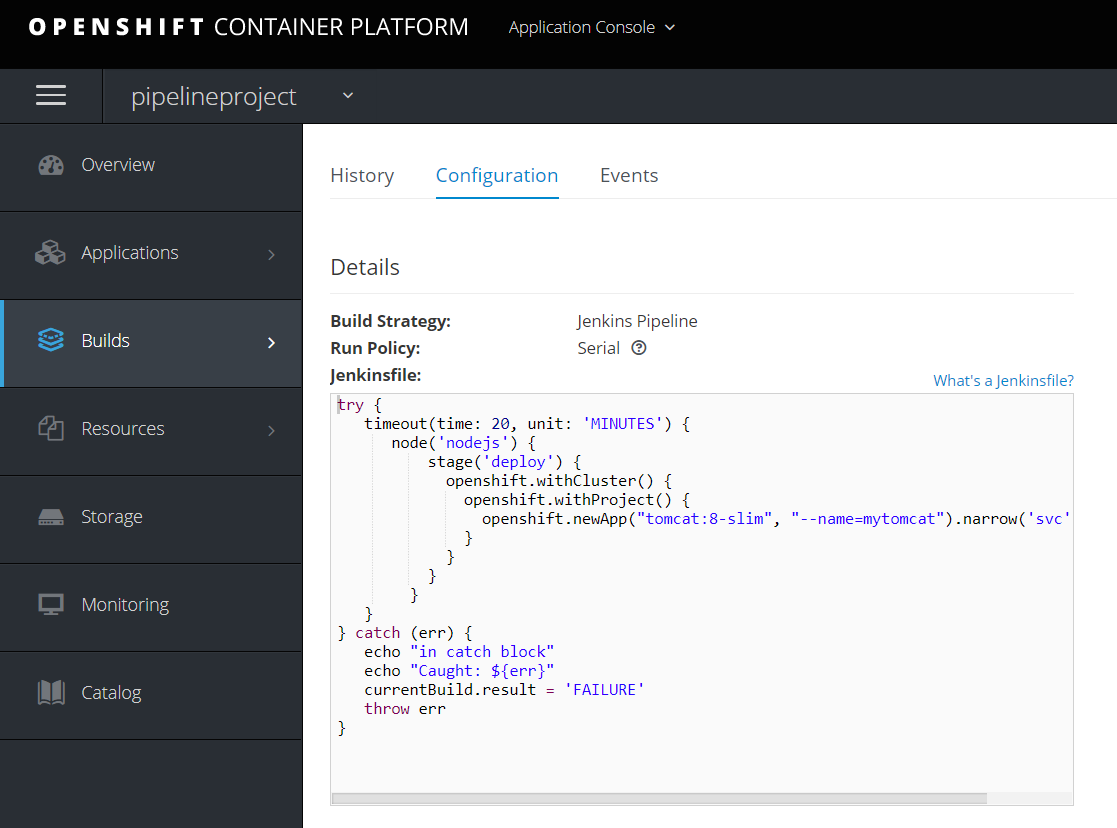
然后运行,发现会启动一个jenkins slave,然后创建一个mytomcat的应用和服务。

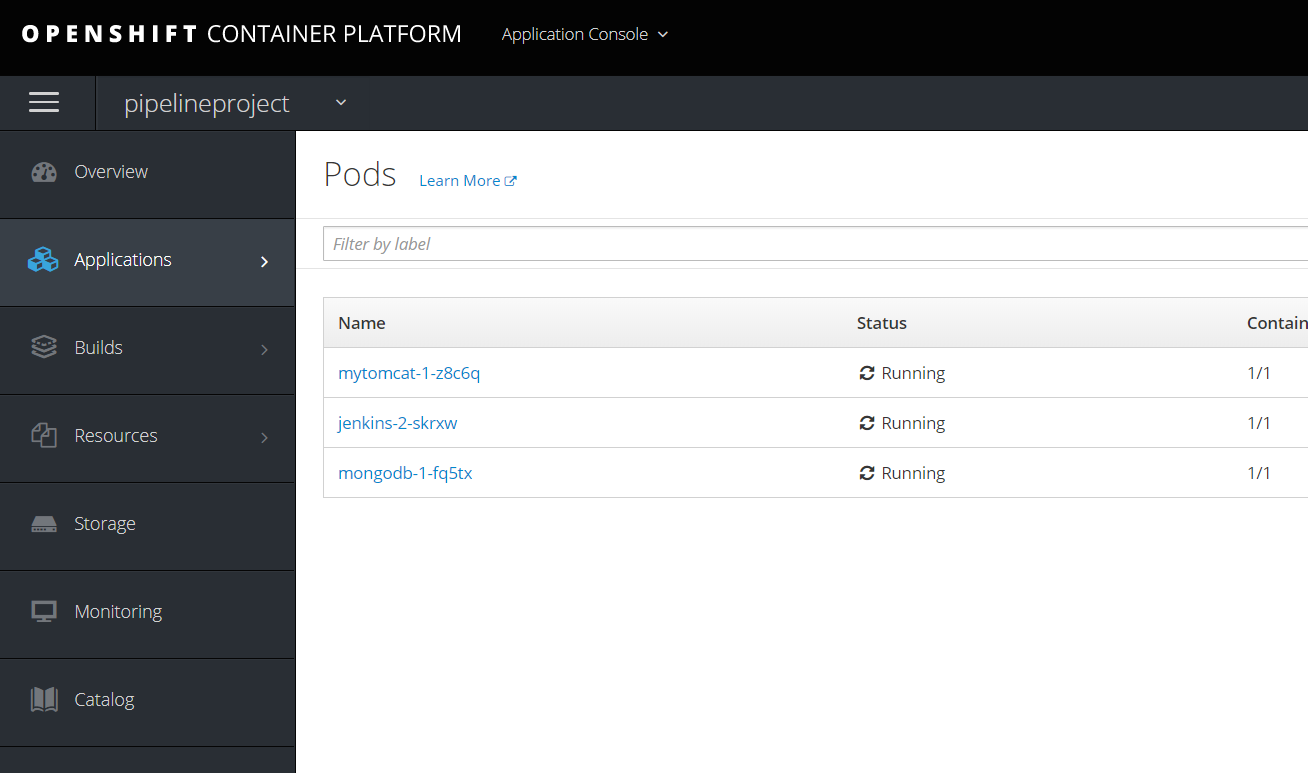
修改pipeline里面的内容为,也就是说prepare阶段输出project名,Approval阶段需要用户输入意见,deploy阶段会在myproject项目中部署一个应用。
try { timeout(time: 20, unit: 'MINUTES') { node('nodejs') { stage('prepare') { openshift.withCluster() { openshift.withProject() { echo "Using project: ${openshift.project()}" } } } stage('Approval') { timeout(time: 2, unit: 'HOURS') { input message: 'Approve Deploy?', ok: 'Yes' } } stage('deploy') { openshift.withCluster() { openshift.withProject("myproject") { openshift.newApp("tomcat:8-slim", "--name=mytomcatcicd").narrow('svc').expose() } } } } } } catch (err) { echo "in catch block" echo "Caught: ${err}" currentBuild.result = 'FAILURE' throw err }
需要把jenkins加入myproject的admin权限。
oc adm policy add-role-to-user admin system:serviceaccount:pipelineproject:jenkins -n myproject
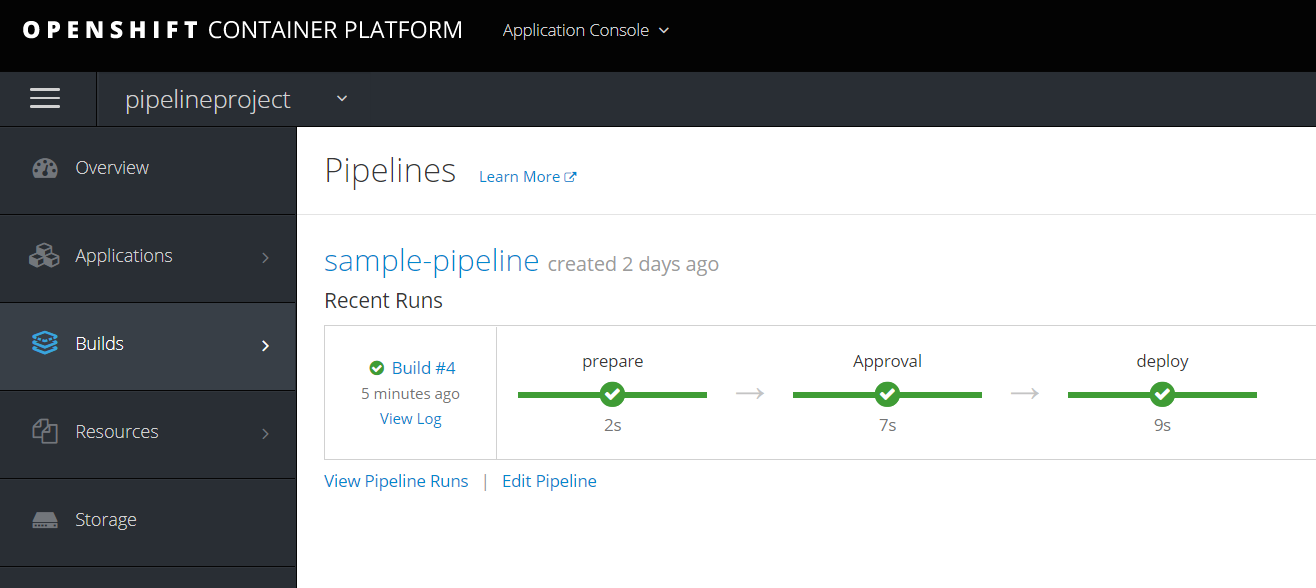
多集群支持详见
https://github.com/openshift/jenkins-client-plugin/
https://docs.openshift.com/container-platform/3.9/dev_guide/dev_tutorials/openshift_pipeline.html